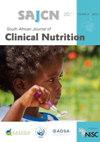Prevalence of anaemia in pregnancy and associated factors in northern Uganda: a cross-sectional study
IF 0.6
Q4 NUTRITION & DIETETICS
引用次数: 0
Abstract
Background: Anaemia in pregnancy is associated with poor maternal and foetal outcomes. Nonetheless, there is a paucity of recent literature on the predictors of anaemia during pregnancy in the context of northern Uganda, a region emerging out of decades of war. A study was undertaken to determine the prevalence and factors associated with anaemia among pregnant women in northern Uganda. Methods: In this cross-sectional study, 320 pregnant women seeking care at Lira Regional Referral Hospital were consecutively enrolled. Data were collected using a structured interviewer-administered questionnaire. Data collected included: demographic, obstetric, nutritional and dietary characteristics of study participants. Data analysis consisted of descriptive statistics, cross-tabulations and logistic regression with 95% confidence and a p-value of < 0.05 as significant using STATA version 14. Results: The mean age of the women was 25.3 ± 5.6 years while their mean gestational age was 25.4 ± 7.8 weeks. The overall prevalence of anaemia (Hb < 11 g/dl in the first and third trimesters and less than 10.5 g/dl in the second trimester) was 24.7%. Iron deficiency was prevalent in half of the women (50%) with anaemia. Factors independently associated with anaemia included taking antimalarial prophylaxis (AOR 0.44; 95% CI 0.19, 0.99) and consumption of legumes and cereals more than twice in the previous week (AOR 0.46; 95% CI 0.24, 0.89). Conclusion: One-quarter of pregnant women in this study population based in northern Uganda were anaemic. There is a need to strengthen interventions to control anaemia during pregnancy, particularly the intake of antimalarial prophylaxis and consumption of iron-rich locally available foods.乌干达北部孕妇贫血患病率及相关因素:一项横断面研究
本文章由计算机程序翻译,如有差异,请以英文原文为准。
求助全文
约1分钟内获得全文
求助全文
来源期刊

South African Journal of Clinical Nutrition
NUTRITION & DIETETICS-
CiteScore
2.50
自引率
9.10%
发文量
21
期刊介绍:
1.The Journal accepts articles from all basic and applied areas of dietetics and human nutrition, including clinical nutrition, community nutrition, food science, food policy, food service management, nutrition policy and public health nutrition. 2.The Journal has a broad interpretation of the field of nutrition and recognizes that there are many factors that determine nutritional status and that need to be the subject of scientific investigation and reported in the Journal. 3.The Journal seeks to serve a broad readership and to provide information that will be useful to the scientific community, the academic community, government and non-government stakeholders in the nutrition field, policy makers and industry.
 求助内容:
求助内容: 应助结果提醒方式:
应助结果提醒方式:


